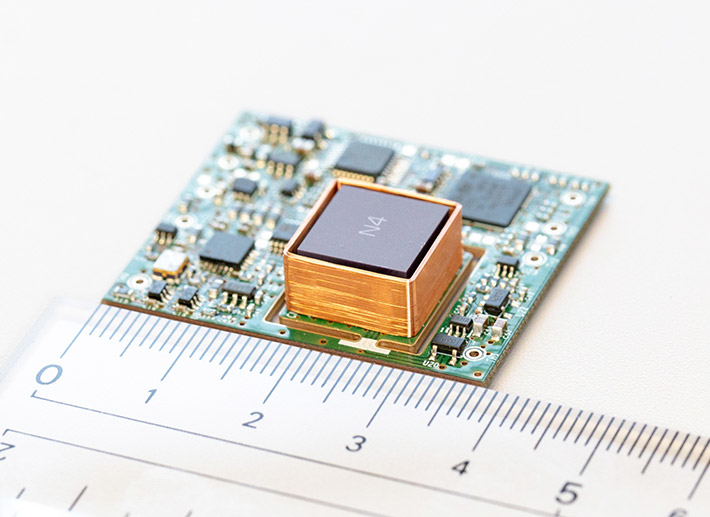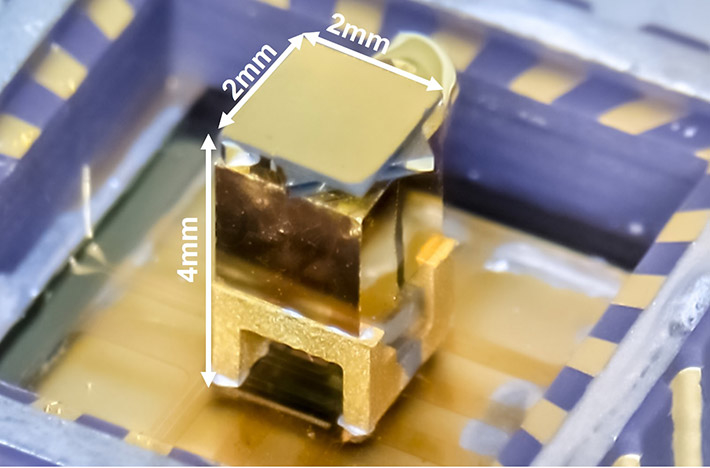Scientists at Tokyo Tech, Ricoh co. and The National Institute of Advanced Industrial Science and Technology have developed an ultra-low-power atomic clock (ULPAC) for small satellites to enable future communication systems beyond 5G. The proposed device outperforms the current industry standards in various benchmarks, such as size, stability, and power consumption.

Figure 1. Prototype of the atomic clock (33 mm x 38 mm x 9 mm)
A newly developed compact ULPACs, mounted on small satellites, automobiles, and smartphones, accelerate the realization of seamless and on-demand mobile communication networks.
As current telecommunication technologies continue to evolve, the speed and sheer amount of data required by users worldwide increase accordingly. One promising method for satisfying this ever-growing demand is by deploying a constellation of nano- or micro-scale satellites that circle the planet in low earth orbit. However, such a swarm of satellites requires extremely precise synchronization to a global time standard, for which a very precise atomic clock on board each unit is necessary.
Because conventional atomic clocks are too large (155–755 cm3) and consume too much power (up to 10 W) to be employed on small satellites, researchers have developed quantum atomic clocks with greatly reduced size and power consumption by employing a method called coherent population trapping. Based on this method, researchers at Tokyo Tech, together with Ricoh Co. Ltd. and the National Institute of Advanced Industrial Science and Technology (AIST), have recently designed a fully functional atomic clock that surpasses the current industry benchmarks. In terms of power consumption, the phase-locked loop of their device, which is an essential component in quantum atomic clocks, consumes an order of magnitude less power than that of previously reported devices.
In addition to its low power consumption, the proposed atomic clock outshines currently reported devices in two other critical aspects: volume occupied and Allan deviation. Because effective use of the available space on board nano/micro-scale satellites is of the essence, so is making sure that the final design can be made to fit a very small volume. As for Allan deviation, it is a measure of the stability of the frequency of a clock; a low Allan deviation implies a very stable and reliable clock. The atomic clock developed by the team is also looking good in these two fronts as well. "The prototype of our atomic clock achieves a long-term Allan deviation of 2.2×10−12 at τ=105 s (the industry standard is 3.0×10−10 at τ=1 s) while occupying a volume of only 15.4 cm3 (slightly smaller than the smallest currently available atomic clock)," explains Associate Professor Kenichi Okada from Tokyo Tech.
According to the research team, there is room for improvement. "The total power consumption is 59.9 mW, which is mainly because of the microcontroller unit in this prototype and can be further reduced by using custom logic circuitry," explains Okada. A photograph of the finished product can be seen in Fig. 1 and 2. Ricoh and AIST worked on improving the Allan deviation of the device, whereas the researchers at Tokyo Tech focused on lowering its power consumption. The final result of this collaboration is a prototype of a very promising atomic clock that pushes current benchmarks further so that future telecommunications systems, such as those beyond 5G, can become a reality.

Figure 2. The integrated quantum package
The quantum package of the proposed low-power atomic clock fits in a volume even smaller than the smallest atomic clocks currently available.
Reference
Authors : |
Haosheng Zhang1, Hans Herdian1, Aravind Tharayil Narayanan1, Atsushi Shirane1, Mitsuru Suzuki2, Kazuhiro Harasaka2, Kazuhiko Adachi2, Shinya Yanagimachi3, Kenichi Okada1 |
Session : |
Session 29: Quantum & Photonics Technologies |
Session title : |
Ultra-Low-Power Atomic Clock for Satellite Constellation with 2.2×10−12 Long-Term Allan Deviation Using Cesium Coherent Population Trapping |
Affiliations : |
1Tokyo Institute of Technology
2Ricoh
3National Institute of Advanced Industrial Science and Technology
|
Conference : |
|
DOI : |
|
- *
- This article has been updated to add DOI on March 26.
. Any information published on this site will be valid in relation to Science Tokyo.





